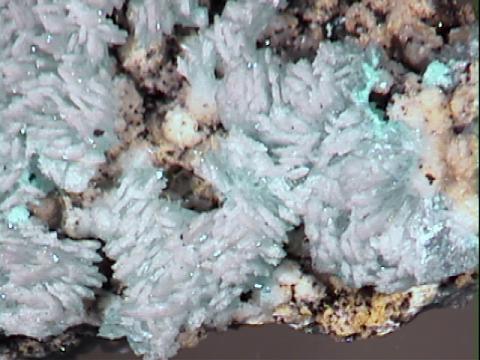 THE MINERAL HEMIMORPHITE
THE MINERAL HEMIMORPHITE
- Chemistry: Zn4 Si2 O7 (OH)2 -H2O, Hydrated Zinc Silicate Hydroxide.
- Class: Silicates
- Subclass: Sorosilicates
- Uses: minor ore of zinc
Specimens
Hemimorphite was originally named calamine but this name had been used for another mineral and hemimorphite was proposed and is now in wide spread use. The hemi means half while the morph means shape and thus hemimorphite is aptly named. Only a few other minerals show hemimorphic character such as tourmaline, but none show it as well as hemimorphite. Clusters of hemimorphite that show well shaped crystals do not always show the hemimorphic character. Because the crystals of a single specimen tend to grow outward with either the "top" or the "bottom" as the overall orientation for that specimen. In order to see the hemimorphic character either a doubly terminated specimen is necessary or two different clusters with different orientations will be needed.
Specimens of hemimorphite tend to be of two very different forms (seems like a trend with this mineral). One form produces very glassy, clear or white, thin, bladed crystals, often well formed showing many crystal faces. Many times these crystals are arranged in fan shaped aggregates. The other form produces a blue to blue-green botryoidal crust that resembles smithsonite or prehnite. Prehnite has a lower density and is usually greener and has different associations with other minerals. Smithsonite has a shimering luster that causes a play of light across the rounded surfaces and has a higher density that hemimorphite. Often hemimorphite will show rough crystal ridges or "cock's comb" structures over top of the basic botryoidal crust. For a collector both forms are a must in their mineral collections.
PHYSICAL CHARACTERISTICS:
- Color is blue-green, green, white, colorless, brown and yellow.
- Luster is vitreous in large crystals to dull in more compact forms.
- Transparency crystals are transparent to translucent.
- Crystal System is orthorhombic; mm2
- Crystal Habits include the bladed crystal form and the botryoidal form as the most common. The crystals are usually elongated and flat. The terminations are different at each end. One termination is blunted by a pedion face that is usually bevelled by several dome faces. The other end is pointed, being capped by a pyramid. The other common form is botryoidal producing a grape bunch texture. Often the botryoidal form has a cock's comb appearance showing rough crystal terminations.
- Cleavage is perfect in one direction.
- Fracture is conchoidal to subconchoidal.
- Hardness is slightly less than 5.
- Specific Gravity is approximately 3.4+ (above average)
- Streak is white.
- Associated Minerals include limonite, aurichalcite, calcite and smithsonite.
- Other Characteristics: strongly pyroelectric and piezoelectric.
- Notable Occurrences include Santa Eulalia and Mapimi, Mexico; New Mexico and New Jersey, USA: England and Zambia.
- Best Field Indicators are crystal habit, color, density and luster.






































